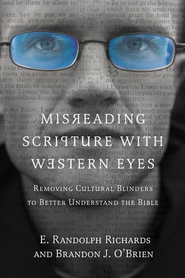 Richards, E. Randolph, and Brandon J. O’Brien. 2012. Misreading Scripture with Western Eyes: Removing Cultural Blinders to Better Understand the Bible. Downers Grove, IL: IVP Books.
Richards, E. Randolph, and Brandon J. O’Brien. 2012. Misreading Scripture with Western Eyes: Removing Cultural Blinders to Better Understand the Bible. Downers Grove, IL: IVP Books.
Who we are affects how we read the Bible, and culture shapes who we are to a significant degree. For example, a married, middle-aged man from Springfield, Missouri, interprets the Bible differently than an unmarried, teenage girl from Banda Aceh, Indonesia. This doesn’t mean that Scripture has no correct interpretation. It does mean, however, that we shouldn’t assume ours is it.
Misreading Scripture with Western Eyes by Randy Richards and Brandon O’Brien identifies nine key areas where Western cultural assumptions differ from biblical cultural assumptions. These areas have to do with mores, ethnicity, language, individualism and collectivism, honor/shame and right/wrong, time, rules and relationships, virtue and vice, and the identity of the center of God’s will. The authors devote a chapter to each area, mixing cross-cultural anecdotes (often drawn from the mission field) and examples from Scripture to show how Western ways of reading can misinterpret biblical teaching.
Chapter 3, for example, shows how, among other assumptions about language, Westerners prefer propositions to metaphors. “Because we are somewhat uncomfortable with the ambiguity of metaphors,” the authors write, “we tend to distill propositions out of them.” The biblical authors didn’t share our discomfort with metaphors, however. They “recorded the profoundest truth in similes, metaphors, parables and other colorful and expressive (and potentially ambiguous) forms of language.” The Western tendency to distill propositions out of metaphors “actually diminishes the breadth and application of the text.” What proposition better expresses, theologically and emotionally, God’s providential care of us than “The Lord is my shepherd” (Psalm 23:1)? Moreover, “the biblical writers use metaphors to connect central truths in Scripture.” When Jesus said of himself, in John 10:14, “I am the good shepherd,” he drew on both Psalm 23 and Ezekiel 34, where God called himself a shepherd. His opponents rightly discerned that he was claiming to be God (John 10:33). Unlike propositions, metaphors “say more with less.”
By identifying ways that Westerners misread Scripture, Randolph and O’Brien help them cultivate more faithful ways of reading and applying Scripture. I recommend this book to preachers, theological students, and would-be missionaries. It is written at an introductory level and includes a list of recommended books for more in-depth study of the relationship between culture and biblical interpretation.
P.S. If you found my review helpful, please vote “Yes” on my Amazon.com review page.

